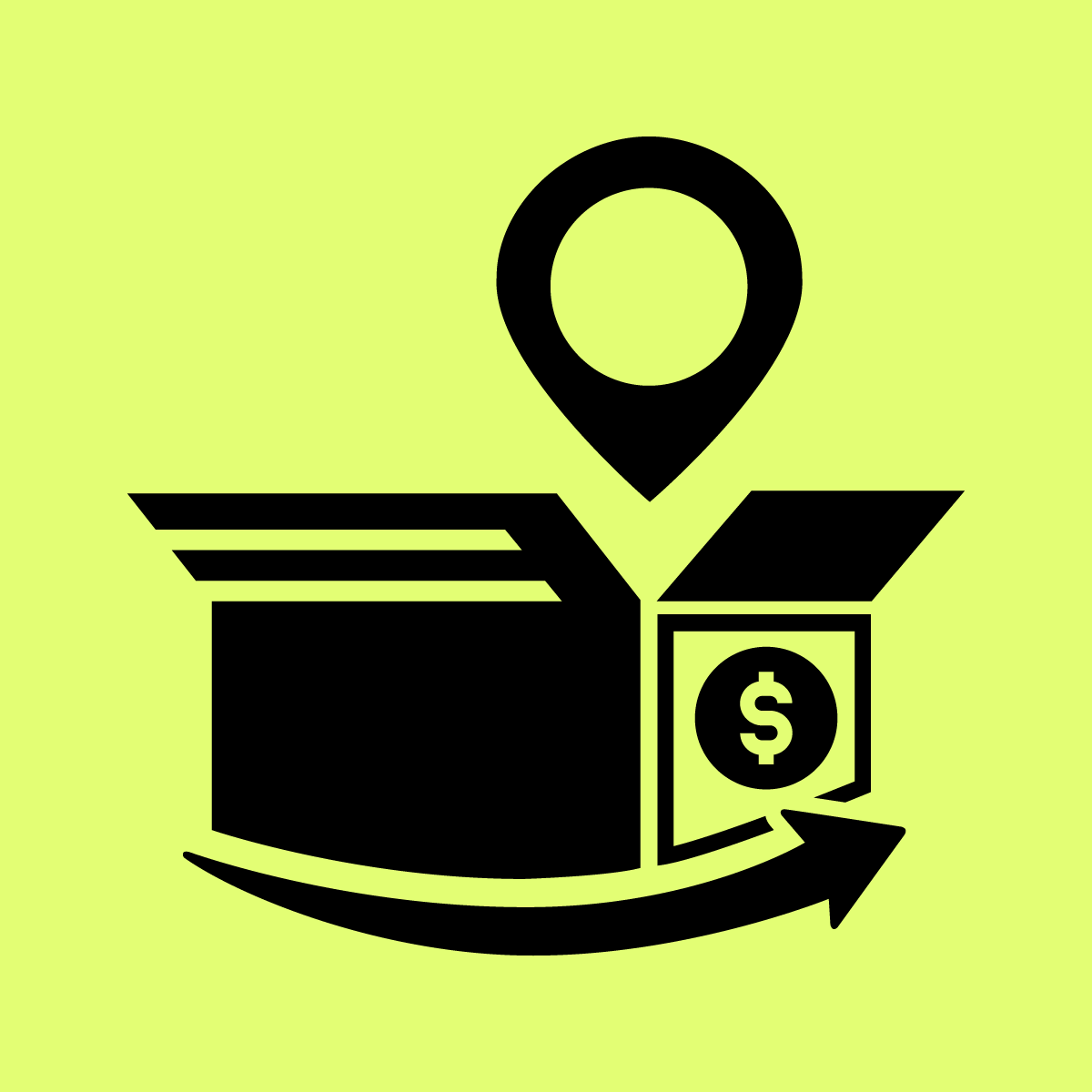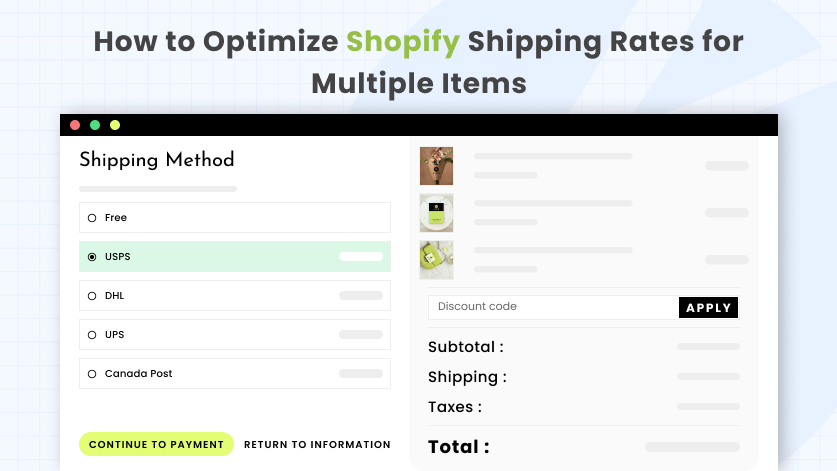Shopify shipping rates for multiple items can be complex to solve, but don’t worry! This guide aims to provide you with a complete understanding of how to navigate the complex shipping rates for multiple items.
Our detailed insights and practical tips will help you optimize cost-effective shipping, whether you’re an online retailer, business owner, or individual shipping package.
Shipping rates for multiple items, also known as multi-item shipping rates, refer to the cost associated with sending more than one item in a single shipment.
These rates are influenced by various factors, including the combined weight, dimensions, destination, shipping method, and any additional services you choose. Understanding how these components interact is crucial for the accurate and estimation shipping rates for effective planning.
Understanding Shipping Rates for Multiple Items:
When you ship multiple items together, the shipping cost isn’t simply a sum of the individual shipping costs for each item. Instead, it takes into account various factors that influence the overall cost of the shipment.
These factors include the combined weight of all the items, the dimensions of the package they’re being shipped in, the shipping method you choose, the destination where the items are being sent, and any additional services you might opt for.
Let’s break down these factors in more detail:
1. Free Shipping Rates: The Psychology of “Free”
The concept of “free” is a powerful strategy to attract customers. Customers have a positive emotional response and a sense of getting something valuable without additional costs when they see the word “free”. Businesses use this psychological response to attract customers and drive conversions.
When businesses offer free shipping rates, they absorb the shipping costs themselves rather than passing them to the customers.
Benefits of Using Free Shipping Rates:
- Higher Conversion Rates: The promise of free shipping can lead to increased conversion rates. Customers are more likely to complete a purchase when they know they won’t be charged extra for shipping.
- Reduced Cart Abandonment: High shipping costs are a common reason for cart abandonment. Offering customers free shipping can reduce cart abandonment rates and encourage customers to finalize their purchases.
- Competitive Advantage: In a competitive market, offering free shipping can help a business stand out. It can be an important factor in a customer’s decision to choose one business over another.
- Perceived Value: Customers consider free shipping as an added value. Even if the product is a little more expensive, the lack of shipping fees can make the overall deal look more attractive.
2. Flat Shipping Rate: Predictable and Manageable:
A flat shipping rate is a fixed shipping rate that remains consistent regardless of the weight, size, or quantity of the items being shipped. Unlike variable shipping rates that change based on different factors, a flat rate simplifies the shipping process by offering a uniform cost for all orders.
Benefits of Using Flat Shipping Rates:
- Predictability: One of the key advantages of using a flat shipping rate is predictability. Both customers and businesses know exactly how much the shipping will cost for each order. This transparency enhances the shopping experience and eliminates any surprises during checkout.
- Simplicity: Flat shipping rates simplify the decision-making process for customers. They don’t need to calculate shipping costs based on item specifics, making the purchasing experience quicker and more straightforward.
- Customer Satisfaction: Customers appreciate clear and upfront pricing. Flat rates eliminate concerns about high shipping costs, reducing the likelihood of cart abandonment due to unexpected expenses.
- Incentive to Buy More: Flat rates can incentivize customers to add more items to their carts. Since the shipping cost remains constant regardless of the order size, customers may feel encouraged to make larger purchases to maximize value.
- Cost Management for Businesses: For businesses, flat shipping rates allow for better cost management. It becomes easier to budget and allocate resources, as the shipping expenses are more consistent.
- Competitive Advantage: Offering flat shipping rates can set a business apart from competitors. It’s a straightforward and customer-friendly approach that can attract more buyers.
Flat shipping rates offer a win-win solution for both customers and businesses. They provide predictability, transparency, and simplicity to the shipping process, resulting in higher customer satisfaction and potentially increased sales of your store.
By strategically implementing flat shipping rates businesses can enhance the shopping experience and build stronger relationships with their customers.
3. Tiered or Promotional Shipping: Data-Driven Advantage:
Tiered or promotional shipping involves offering different shipping options based on specific criteria, such as order value, shipping speed, or customer loyalty. These options provide customers with choices while allowing businesses to strategically influence purchasing behavior.
Benefits of Tiered or Promotional Shipping:
- Customization: Tiered shipping allows businesses to offer various shipping options that align with different customer needs. For example, customers can choose between standard, expedited, or same-day delivery based on their preferences and urgency.
- Incentivizing Higher Spending: By setting different shipping tiers based on order value, businesses can encourage customers to spend more to unlock faster or even free shipping.
- Customer Loyalty: Implementing tiered shipping based on customer loyalty levels, such as membership or repeat purchases, can reward loyal shoppers with exclusive shipping perks, fostering a sense of appreciation and retention.
- Data Utilization: Data-driven decisions are at the core of tiered shipping. By analyzing customer preferences, purchasing behavior, and historical data, businesses can tailor shipping options to align with what customers are likely to choose.
- Conversion Optimization: Offering tiered shipping based on data insights can enhance the chances of conversion. For example, displaying a progress bar showing how much more a customer needs to spend to qualify for free shipping can motivate additional purchases.
Implementing Tiered or Promotional Shipping:
- Analyze Customer Data: Start by analyzing your customer data to identify trends, preferences, and spending patterns. This will help you determine which tiers are most relevant and attractive to your customer base.
- Set Clear Criteria: Define the criteria for each shipping tier, such as minimum order value, shipping speed, or customer loyalty level. Ensure these criteria are clearly communicated to customers.
- User-Friendly Interface: Design your website’s interface to showcase the different shipping options prominently during the checkout process. Make it easy for customers to understand and select their preferred option.
- Testing and Optimization: Continuously monitor the performance of your tiered shipping strategy. Test different criteria, messaging, and incentives to find the combinations that resonate most with your customers.
Tiered or promotional shipping is a data-driven strategy that empowers businesses to cater to various customer preferences, optimize costs, and drive sales.
By leveraging insights from customer behavior and preferences, businesses can offer shipping options that align with what customers lifetime value most.
This strategy improves the overall shopping experience, fosters customer loyalty, and positions businesses for success in a competitive market.
4. Weight-Based Shipping: Precision in Pricing
Weight-based shipping is a pricing model where the cost of shipping is determined by the total weight of the items in the order. Heavier shipments incur higher shipping costs due to the additional resources needed for handling, packaging, and transportation.
Benefits of Weight-Based Shipping:
- Accuracy: Weight-based shipping offers accurate pricing that corresponds directly to the weight of the items. This precision helps both businesses and customers understand the rationale behind the shipping cost.
- Fairness: Weight-based pricing is perceived as fair by customers. They see the shipping cost as proportional to the resources required to transport their items, resulting in fewer surprises during checkout.
- Cost Recovery: For businesses, weight-based shipping helps recover the actual costs associated with heavier shipments. This prevents undercharging for shipping and ensures that shipping expenses are covered.
- Transparency: Transparency in pricing builds trust with customers. When they understand that the shipping cost is based on the weight of their items, they’re more likely to perceive the pricing as reasonable.
Weight-based shipping is an accurate and transparent pricing strategy that benefits both businesses and customers.
By calculating shipping costs based on the actual weight of items, businesses can ensure fairness, accuracy, and cost recovery.
This approach builds trust with customers and provides a clear understanding of how shipping costs are determined, ultimately leading to a positive shopping experience.
5. Price-Based Shipping: Incentivizing Higher Spending
Price-based shipping is a strategy where the cost of shipping is determined by the total value of the items in the order. Customers who reach a certain minimum order value may qualify for free or discounted shipping rates, incentivizing them to add more items to their carts.
Benefits of Price-Based Shipping:
- Encourages Higher Spending: Price-based shipping motivates customers to add more items to their orders in order to qualify for better shipping rates. This can result in increased average order values and higher revenue for businesses.
- Competitive Advantage: Price-based shipping can set a business apart from competitors, especially if those competitors do not offer similar incentives for higher spending.
- Customer Satisfaction: Customers appreciate incentives that reward their spending. Free or discounted shipping makes them feel like they’re getting added value, enhancing their overall shopping experience.
Price-based shipping is a strategic approach that encourages customers to spend more by offering shipping incentives based on order value.
By providing tangible rewards for higher spending, businesses can reduce cart abandonment, increase average order values, and create a positive shopping experience for customers.
This strategy aligns with customer preferences for value-driven incentives and can contribute to the overall success of a business’s eCommerce efforts.
Before we go to the next of the understanding shipping rates for multiple items. Do you know the success rate of the Shopify store?
Don’t worry here is the answer.
The Shopify Success Rate of eCommerce stores is around 5% to 10%. This means that out of every 100 businesses that use Shopify, only about 5 to 10 businesses of them are successful.
Here is the detailed guide on the Shopify success rate.
6. Calculated Shipping Rates: Precision through Integration
Calculated shipping rates involve using real-time data from shipping carriers to calculate the exact cost of shipping based on factors such as package weight, dimensions, shipping destination, and chosen shipping method.
This approach ensures that customers are charged the most accurate shipping cost for their specific order.
Benefits of Calculated Shipping Rates:
- Accuracy: Calculated shipping rates provide the most accurate shipping costs because they are based on real-time data from carriers. This accuracy helps businesses avoid overcharging or undercharging customers for shipping.
- Fairness: Customers appreciate fairness in pricing. Calculated rates ensure that customers pay only for the shipping services they’re actually using, which builds trust and enhances the shopping experience.
- Dynamic Pricing: Since calculated rates consider factors such as package weight and destination, they adjust dynamically as customers add items to their carts. This reflects the true cost of shipping based on the items selected.
- Cost Transparency: Transparency in pricing is essential for customer satisfaction. Calculated rates clearly show customers how the shipping cost is determined, creating a sense of trust and clarity.
Calculated shipping rates offer a highly accurate and transparent pricing model that benefits both businesses and customers. By integrating with shipping carriers and leveraging real-time data, businesses can provide precise shipping costs based on factors such as package weight and destination.
This approach enhances customer trust, prevents pricing discrepancies, and ensures that customers pay only for the shipping services they use. As a result, calculated shipping rates contribute to a positive shopping experience and overall customer satisfaction.
Note: No matter which method you choose, make sure to test your shipping rates before you go live. This will help you to ensure that your customers are getting accurate shipping rates.
How to Set up Shopify Shipping Rates For Multiple Items:
Here are the steps on how to set up Shopify shipping rates for multiple items:
- Go to your Shopify admin and click Settings > Shipping and delivery.
- Click General Shipping Rates.
- Click Add Rate.
- In the Name field, enter a name for your shipping rate.
- In the Conditions section, select the Based on order weight option.
- In the Weight range field, enter the minimum and maximum weight of the items that this shipping rate applies to.
- In the Price Based on section, select the option that you want to use to calculate the shipping price. You can choose from:
- Set a fixed price
- Set a price per unit
- Set a price per weight
- Enter the shipping price in the Price field.
- Click Save.
You can repeat these steps to add as many shipping rates as you need.
You can also use a third-party Shopify app called “ShipZip – Shipping and Delivery” to set up shipping rates for multiple items. This app offers a variety of features that can help you customize your shipping rates, including:
- Rates are based on weight, pickup location, and delivery zip code.
- Local delivery and multi-origin shipping.
- Local pickup in multiple locations.
- Ability to handle complex shipping needs.
- Free test mode for trial before going live.
If you’re looking for a way to set up shipping rates for multiple items in Shopify, I recommend using “ShipZip – Shipping and Delivery”. It’s a powerful and easy-to-use app that can help you save money and improve your shipping process.
How to Add Shipping Rates to your Shopify Store:
Adding shipping rates to your Shopify store is a crucial step in setting up your eCommerce business. Accurate and transparent shipping rates are essential for customer satisfaction and can help reduce cart abandonment rates.
Here’s a step-by-step guide on how to add shipping rates to your Shopify store:
Step #1: Log in to your Shopify account:
- Go to Shopify’s website (www.shopify.com) and log in to your account using your credentials.
Step #2: Access shipping settings:
- In your Shopify admin dashboard, navigate to “Settings” located on the lower left-hand side of the screen.
Step #3: Configure shipping zones:
- Under the “Settings” menu, click on “Shipping and delivery”.
- You’ll see a section labeled “Shipping zones”. Shipping zones allow you to define different regions where you’ll be shipping products. By default, Shopify sets up a “Rest of the world” shipping zone.
- To add a new shipping zone, click on “Add shipping zone”.
- Name your shipping zone, and select the countries or regions it includes. You can set up multiple zones if you ship to various areas with different rates.
Step #4: Add shipping methods:
- After setting up a shipping zone, you’ll need to add shipping methods. Shipping methods are the options customers will see during checkout, such as standard shipping, express shipping, or free shipping.
- Click on the shipping zone you just created.
- In the “Shipping methods at [Your Zone Name]” section, click on “Add rate” next to the shipping zone to which you want to add rates.
Step 5: Configure shipping rates:
- You will now be able to configure the shipping rates for this zone.
- Choose a rate name (e.g., “Standard Shipping” or “Express Shipping”) to make it clear for customers.
- Determine how you want to calculate the shipping rate. Shopify offers several options:
- Price-based: You can set rates based on the total price of the order.
- Weight-based: Rates are calculated based on the total weight of the items in the cart.
- Flat rate: A fixed shipping cost regardless of order price or weight.
- Carrier-calculated: Use real-time rates from carriers like USPS, FedEx, or UPS.
- Free shipping: Offer free shipping for orders over a certain amount.
- Set the rates based on your chosen calculation method. You can either set specific prices, percentages, or thresholds.
Step #6: Customize shipping settings:
- Further, customize your shipping rates by adjusting additional settings. You can specify shipping rates for specific products, enable or disable shipping to P.O. boxes, and add handling fees if necessary.
Step #7: Test your shipping rates:
- Before making your store live, it’s essential to test your shipping rates. Go through the checkout process as a customer to ensure that the rates are correctly calculated and displayed.
Step #8: Save your changes:
- Once you are satisfied with your shipping rates and settings, be sure to save your changes.
Step #9: Publish your rates:
- When your store is ready to go live, don’t forget to click the “Enable” button in the shipping zone settings to make your shipping rates visible to customers.
That’s it! You’ve successfully added shipping rates to your Shopify store. Regularly review and update your rates as needed to ensure they remain accurate and competitive.
Providing clear and reliable shipping options is essential for building trust with customers and encouraging sales in your online store.
Empowering your Shopify Shipping Strategy with Shipping Carrier Integration:
Shopify Shipping Carrier refers to the various shipping carriers that Shopify allows eCommerce businesses to integrate with their online stores.
These carriers provide a range of services for shipping products to customers, and Shopify’s integration makes it easy for businesses to offer different shipping options to their customers.
Here’s a detailed explanation of Shopify’s shipping carrier options:
1. USPS (United States Postal Service): USPS is a widely used shipping carrier in the United States. It offers a range of services, including Priority Mail, First-Class Mail, and Priority Mail Express. USPS is known for its cost-effective shipping options, making it suitable for various businesses, especially those shipping domestically.
2. FedEx: FedEx is a global shipping carrier known for its reliability and extensive service network. It provides various shipping options, such as FedEx Ground, FedEx Express, and international shipping services. Integration with FedEx allows businesses to offer both domestic and international shipping solutions.
3. UPS (United Parcel Service): UPS is another global shipping giant that offers a range of services, including UPS Ground, UPS 2nd Day Air, and UPS Worldwide Express. Integrating UPS with Shopify enables businesses to provide customers with various shipping speeds and international shipping capabilities.
4. DHL: DHL is renowned for its international shipping services. Integrating DHL with Shopify is crucial for businesses that serve a global customer base. DHL offers express shipping options for rapid delivery worldwide.
5. Canada Post: For Canadian businesses, Canada Post is the primary shipping carrier. It provides both domestic and international shipping services. Integrating Canada Post with Shopify ensures seamless shipping options for Canadian customers.
6. Custom Shipping Options: Apart from major carriers, Shopify allows businesses to set up custom shipping options. This is valuable for businesses that have unique shipping requirements or work with specialized carriers.
In short, Shopify’s shipping carrier options provide businesses with the flexibility to offer a wide range of shipping services to their customers.
Carefully selecting, integrating, and managing these carriers is crucial for ensuring efficient and cost-effective shipping, enhancing the customer experience, and driving success in eCommerce.
Conclusion:
In conclusion, navigating Shopify shipping rates for multiple items can be complex, but with the right strategies and insights, it becomes an easy and advantageous aspect for an eCommerce business.
We’ve explored various approaches, from leveraging the psychology of “free” to offering flat rates, tiered or promotional shipping, weight-based pricing, and price-based incentives. Each method has its unique benefits, catering to different customer preferences and business needs.
Whether you opt for the simplicity of flat shipping rates, the data-driven advantages of tiered shipping, the precision of weight-based pricing, or the incentive-driven approach of price-based shipping, the key lies in understanding your customer base, analyzing their preferences, and continuously optimizing your strategy.
Moreover, consider the convenience and flexibility offered by third-party apps like ShipZip – Shipping and Delivery. This app can empower you with a variety of features to customize your shipping rates, including options based on weight, pickup location, and delivery zip code. They can streamline the shipping process and enhance the overall shopping experience for your customers.
Remember that integrating calculated shipping rates based on real-time data from carriers can provide the utmost accuracy and transparency, ensuring that customers are charged fairly for their specific orders.
As you explore your eCommerce journey with Shopify, always keep in mind the importance of testing your shipping rates before going live to guarantee that your customers receive accurate pricing and a seamless shopping experience.
Now, let’s turn the spotlight to you, the eCommerce business owner: How do you optimize your shipping rates on Shopify for multiple items? Share your strategies and experiences in the comments.








